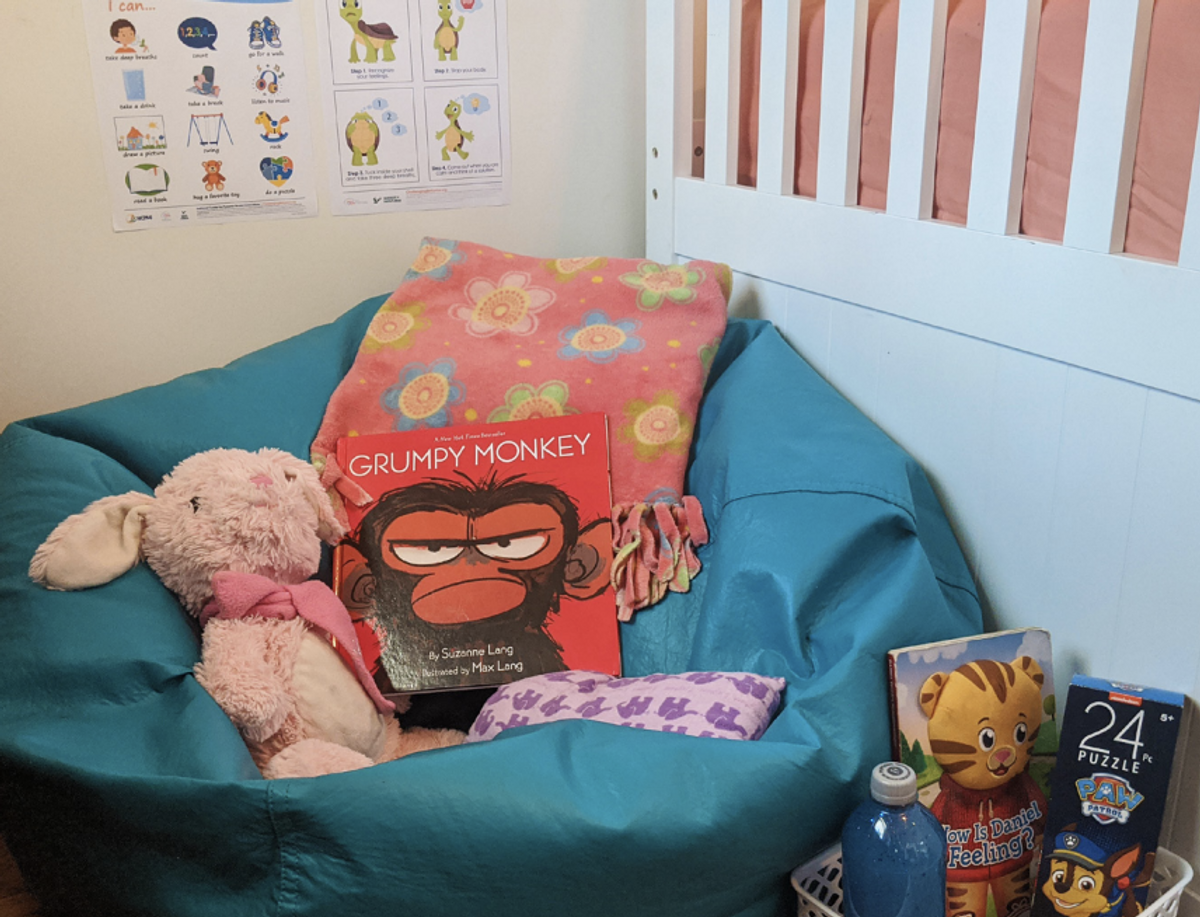Wellbeing

How to Make a Calming Corner
A calming corner (or space, it doesn’t have to be a corner) is a comfortable and calming place for children to go when they need some space, to calm down their bodies, and to take a time-in to process their big feelings.
It is a positive and non-punitive alternative to time-outs that helps children develop emotional regulation, provides structure, and leaves them feeling safe and secure.
The goal when creating a calm down corner is to create a safe space in your home for your child to go if they’re upset or showing signs of anger or frustration. It’s not used to punish bad behaviour, it’s a safe space for processing emotions.
Fill the space with a soft rug or mat, bean bag chair, (or other plush options for sitting or lying down), and with some of your child’s favourite books, stuffed animals or quiet toys. Adding art and journaling supplies allows your child to express their emotions artistically or with the written word. Music is a great calming tool, try having headphones available so the music doesn’t interrupt others in the family. Calm down spaces should also engage as many of your child’s senses as possible, and playdough is an amazing way to do this!
Repeating affirmations is a great self regulation strategy and affirmation cards are a must have resource for all calm down spaces. Affirmations can help shift negative thinking that keeps kids stuck in a dysregulated state, and can be used as a gentle reminder – to breathe, that the feeling will pass, and that your child has a range of strategies at hand that will help them calm down.
Why Should You Create a Calming Corner?
Children don’t misbehave because they want to. They misbehave because they don’t possess the necessary skills required to manage and control their behaviours when they’re in distress.
A calm down corner provides teaching moments so you can help your child develop these lacking skills.
There are multitudinous benefits to using a calm down corner, as opposed to traditional “discipline” or punishments like time-outs or removing privileges.
Here is a look at some of those benefits:
1. Builds Emotional Intelligence
Emotional intelligence is the ability to recognize our feelings, and the feelings of others (empathy), and to use that information to guide how you think and behave.
Early development of emotional intelligence begins with identifying core emotions, such as happy, sad, mad, tired. Later, we develop the ability to recognize more complex feelings, such as annoyed vs furious.
Finally, we learn to use this emotional information to guide behavior and manage emotions through self-regulation.
Your calm down corner will contain all the tools you need to help your child learn and practice these skills.
2. Teaches Children that Unpleasant Emotions are Normal
Everyone feels mad, sad, jealous, etc. from time to time. These emotions are unpleasant to experience but they are normal.
We often tell kids “it’s okay, you don’t need to be sad/mad”, or we isolate them when they feel this way, sending the message that these feelings should be shunned and hidden.
Children should never feel ashamed of their emotions or feel like they’re being punished for feeling a certain way. It’s important to let them know that the way they are feeling is okay.
Instead, unpleasant emotions can be a learning experience.
Your calm down corner will help your child learn that their feelings are valid but certain reactions to those feelings are not.
That knowledge will come through frequent practice and mutual emotional regulation opportunities.
My personal favourite phrase is “It makes sense that you’re feeling ____________, because __________________”. When kids feel validated, they begin learning better ways to communicate emotions.
That learning opportunity is lost if your child is isolated in their bedroom when experiencing big emotions.
3. Calming Corners Provide Structure
Children need structure. They thrive when their lives are consistent and predictable.
This is true for all children but especially important for kids who struggle with rigid thinking.
One of the many ways to add structure to your child’s life is by structuring your home.
Setting up different areas in your home for different parts of the day, activities, or routines helps your child feel safe and secure in their own home.
The calming corner gives your child a safe place to go when they have strong emotions.
A calm down corner, a homework station, a craft centre, etc, are all ways to add this structure to your home.
4. They Help Children Learn from Their Mistakes
First of all, your child should know that everyone makes mistakes. It’s okay to make mistakes, but we need to learn from those mistakes.
Explain to your child that making a mistake can make you feel bad for a little while, but it doesn’t mean that you are bad.
Understanding this helps children tolerate unpleasant emotions better. This “frustration tolerance” (that’s what they call it) is something my own child is working on in therapy.
Continue to reassure your child that their feelings are normal and valid.
But, once they’re calm, explain the impact their actions have on others. Understanding how their behaviour affects the way other people feel is an important part of developing emotional intelligence.
Encourage your child to make things right once they’ve had time to calm down.
I hope that gives you some ideas for setting up your own calm down space! But please remember, that all children are different. They all have different nervous systems and different sensory needs, and what works for one child or in one situation, may not work for another child or in another situation. So just try things! If it doesn’t work out, try something different. And keep trying until you find out what works for your unique child/ren!
Donna Allen



